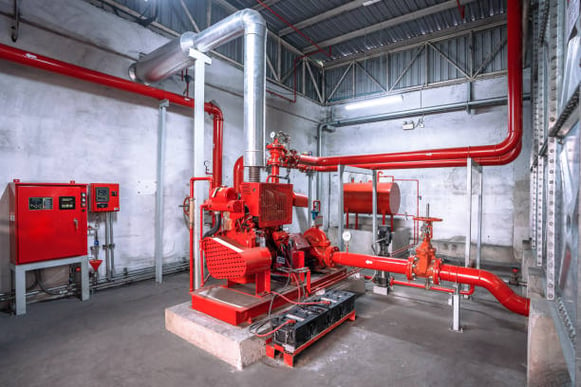A Look at Fire Pump Operations & Maintenance (Part 1 of 2)
Posted on Oct 6, 2021 9:21:08 AM by Jodi Balido, PE, CFPSThe “High Pressure” Lifestyle of a Fire Pump after Commissioning (Part 1 of 2)
If you recently commissioned a fire pump, a number of important steps have probably taken place, but what is next? After the initial installation, inspection, testing, commissioning, and overall service placement, who guides the next steps in operating and managing this critical system?
Answer: The Owner! The Owner is the responsible party that has to deal with the “high pressure” lifestyle of operating and maintaining a fire pump, after its initial commissioning.
 It is High Pressure for All
It is High Pressure for All
A fire pump provides higher pressure and waterflow capacity for a water-based fire suppression system, but Owners are also under high pressure to keep this fire protection at the ready—with everyone’s safety at stake. Proper maintenance of a fire pump (or set of fire pumps) is needed to satisfy fire protection and building codes, comply with insurance requirements, and above all, ensure safety of lives and protection of assets.
Some buildings projects will require only one fire pump. There are some instances, driven by code or by owner preference, to have 100% backup fire pump capacity, which usually means one primary electric driven fire pump and one secondary diesel driven. For large site water supply systems, either for an entire facility campus or industrial plants, one might even see three or more fire pumps to meet the high system demands. Regardless of the number of fire pumps on a fire protection system, Owners need to look at the National Fire Protection Association (NFPA) standards for guidance on how to properly inspect, test, and maintain their fire pump systems. This article will explore some of those requirements and provide some recommendations for complying with those requirements in further detail.
NFPA 20 & NFPA 25: The Fire Pump Standards
NFPA 20, Standard for the Installation of Stationary Pumps for Fire Protection, is the law of the land when it comes to designing, installing, inspecting, testing, commissioning, and placing a fire pump, or set of fire pumps, into service. Once in service, the Owner will need to become very intimate with NFPA 25, Standard for the Inspection, Testing, and Maintenance of Water-Based Fire Protection Systems, in order to keep their fire pump(s) running in top condition.
Keep in mind that NFPA 25 is the inspection, testing, and maintenance (ITM) standard for all water-based fire protection systems. It’s easy to be overwhelmed and confused with all the different sections, various testing, and inspection intervals for the many types of wet suppression systems out there. When it comes to fire pumps, Owners need to focus on NFPA 25’s Chapter 8, which is simply titled “Fire Pumps”. In this chapter, Owners will find a lot of what they need to know for ITM of their fire pumps, including a fire pump’s electrical components, drive system, piping, valves, gauges, controllers, batteries, pump body, filters, oil levels, pump room enclosure, and so forth. Some of these ITM frequencies are often as weekly while some are often as yearly.
For example, NFPA 25, Section 8.3.1.1 requires a weekly no-flow test be conducted for a diesel driven fire pump. The suggested run time for this no-flow test is 10 minutes. During this test, maintenance personnel can check the diesel fire pump for signs of unusual activity, such as irregular movement of piping, excess vibration, or suspicious engine noises. Another item to check for would be the proper operation of the fire pump’s circulation relief valve (also known as the casing relief valve). It is common to see the relief valve discharge water in a no-flow (churn) condition as water pressure builds and water temperature rises. The water discharge is the pump’s way of taking care of itself. If there is no discharge from that relief valve, the fire pump and the associated piping system might be in trouble with over-heating and over-pressurizing.
Another example, NFPA 25, Section 8.3.3 requires annual flow testing of all fire pumps in a facility. This can be a huge undertaking depending on the number of fire pumps and means for discharging the water flow downstream of the fire pump discharge outlet. Some fire pump installations might have an in-line water meter, but these have a tendency to lose calibration and provide inaccurate results. For the best results, the fire pump test header needs to be used. Annual flow testing of a fire pump is an orchestrated effort. Also, it is important to consider where the flowed fire pump water will be discharging. Owners may need to coordinate with their site environmental and safety personnel to control water flow and prevent disruption of nearby landscape and wildlife habitat. Depending on environmental and safety conditions, special waterflow diffusers may be needed.
Performing the Annual Flow Test
As opposed to conducting the test with their own staff, Owners should consider hiring a qualified third-party service contractor to perform the test. There are three major reasons for hiring the qualified service contractor:
- NFPA 25, Section 8.3.3.1 requires the test to be performed by “qualified” personnel, which should be a National Institute for Certification in Engineering Technologies (NICET) certified contractor (with years of experience and has passed examination) or a fire pump distributor (they size, sell, install, and commission fire pumps regularly). The qualified personnel should know the ins-and-outs of fire pumps and should be able to tell if a pump is operating properly or is experiencing issues.
- The contractor has all the necessary personnel to carry out this operation. Hoses and flow measuring devices will need to be connected to the fire pump test header. Valves will need to be operated. Gauges and displays will need to be read, and the data will need to be recorded. Hitting the NFPA 25 required flow targets sometimes requires constant communication for fine tuning between the flow device reader and the test header valve operator. A fire pump flow test is a multi-person job that sometimes a facility maintenance team doesn’t have the manpower to staff properly. Also, maintenance staff are used to working on a number of items in a facility and might not have the expertise of a team that only works on fire pumps all the time.
- The contractor is independent from the Owner. If an Owner were to conduct the test and obtain results on their own, this might be viewed as biased or manipulated from the perspective of a federal regulator, fire marshal, code official, or insurance company. The contractor’s results are non-biased and are not manipulated. They record data as they see it.
Performing the annual flow test for a facility’s fire pump(s) is a crucial part of checking the health of a fire pump system. NFPA 25, Section 8.3.3.1 requires the flow test to be performed at three flow conditions:
- No-flow (churn or 0%) - Accomplished by flowing no water through the pump test header. The pump will be running in a “dead-head” condition.
- 100% flow - Accomplished by flowing 100% the fire pump rated flow through the pump test header and the adequate number of test valves.
- 150% flow - Accomplished by flowing 150% the fire pump rated flow through the pump test header and an even larger number of test valves. For example, if the fire pump is rated at 1,000 gpm, then the 150% rating is 1,500 gpm.
A common issue with these tests is when the contractor shows up on test day without enough test hoses and flow measuring devices to flow the 150% flow rating for fire pumps with high gpm flow rates. A recommendation would be to have a discussion with the contractor before test day to see how many hoses and flow devices will be available. Depending on hose size, a flow measuring device is only good from about 250 gpm to 750 gpm, or 500 gpm on average. For a 1,000 gpm rated fire pump, a safe bet is to bring at least three (3) hoses and flow devices to adequately flow the 1,500 gpm needed to achieve 150% rated flow. Another piece to consider is hose diameter and hose length. Hose diameters should be 2.5-inch to 4-inch diameter, and hose lengths should not exceed 50-feet. Any smaller than 2.5-inch and any longer than 50-ft may create too much friction loss between the pump test header outlet and the flow device, yielding inaccurate results.
Once the proper flow rate is achieved for the particular flow condition, the following values must be recorded as they relate to a fire pump’s performance curve:
- Pump Suction Pressure (PSI) - Read the pressure gauge located on the suction (inlet) side of the fire pump casing.
- Pump Discharge Pressure (PSI) - Read the pressure gauge located on the discharge (outlet) side of the fire pump casing.
- Pump Driver Speed (RPM) - Use a digital tachometer to flash the pump driver shaft and record the pump speed. Some newer model fire pump controllers will have the RPM values on the display. However, it is still good practice to use the handheld tachometer to cross check.
Part 2 goes into depth on how to properly analyze these results and explore various considerations for maintenance and replacement.
Topics

Jodi has more than 13 years of experience in the fire protection industry having worked in multiple types of roles (including design, consulting, inspections, commissioning, product technical support, listings and approvals testing, owners rep, and risk management) and multiple types of projects (including commercial high rise, office, aviation, institutional, healthcare, government, military, and industrial such as power generation and natural gas liquefaction). He is a Licensed Professional Engineer in Fire Protection through National Council of Examiners for Engineering and Surveying (NCEES) and is a Certified Fire Protection Specialist through National Fire Protection Association (NFPA). Jodi also sits as a principal member of the NFPA Building Service & Fire Protection Equipment technical committee that serves NFPA 101, Life Safety Code, and NFPA 5000, Building Construction & Safety Code.
